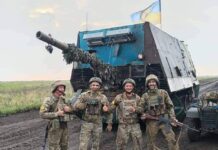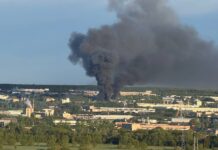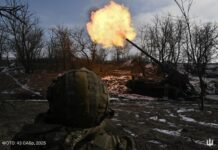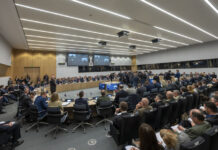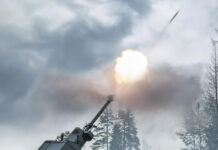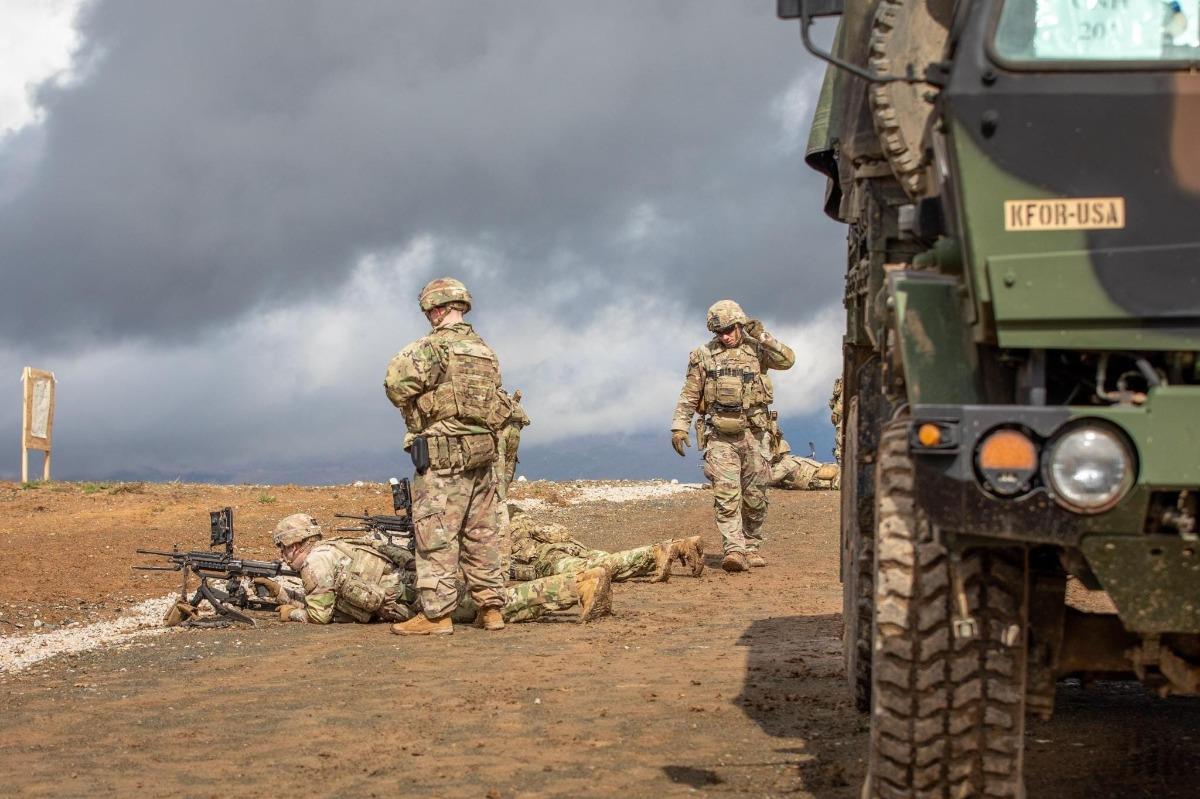
European security in the Balkan neighbourhood
Lincoln Gardner
The Western Balkans are at risk of becoming increasingly forgotten amidst a resurgent US policy towards Russia. As the EU frantically races to fill the growing vacuum left by an increasingly uncompromising US foreign policy on Ukraine, some in the region may choose to find their own way and return to the darker side of their recent history.
With the second Trump administration wasting no time in flexing its muscles on the international stage, the global order that Europe had become accustomed to has once more been turned on its head. Overnight the victim in Ukraine has become the aggressor, in the process of being bullied into a hasty peace by its former staunch ally. As the world continues its preoccupation with Russia’s war against Ukraine (which has recently surpassed three years in duration), the Western Balkans are experiencing a corresponding rise in internal discord and political unrest, coupled with worrying bouts of tension between neighbours.
This fragmented and fragile region, after years of instability following their own bloody and brutal wars in the 1990s, thanks to complex ethnic and historical issues, once again finds itself at critical juncture. While the world waits on Trump’s next foreign policy moves, many observers see the Western Balkans being left to cope alone. This article takes a brief look at parts of the region, with a focus on the growing discord and instability in Bosnia and Herzegovina (BiH), the student-led mass protests in Serbia, and increased nationalist rhetoric coming out of Skopje, North Macedonia. The article also explores the changing dynamic in this fractious region, looking at how issues are aggravated by the shift in geopolitical focus by both the US, but also a lethargic EU in this region of Europe. The article reflects the view that with leading global actors – the US and EU – intensively engaged elsewhere (mainly Ukraine), the Western Balkans might increasingly be left to its own devices as it is forced to navigate a worrying period of unpredictability on the European continent.
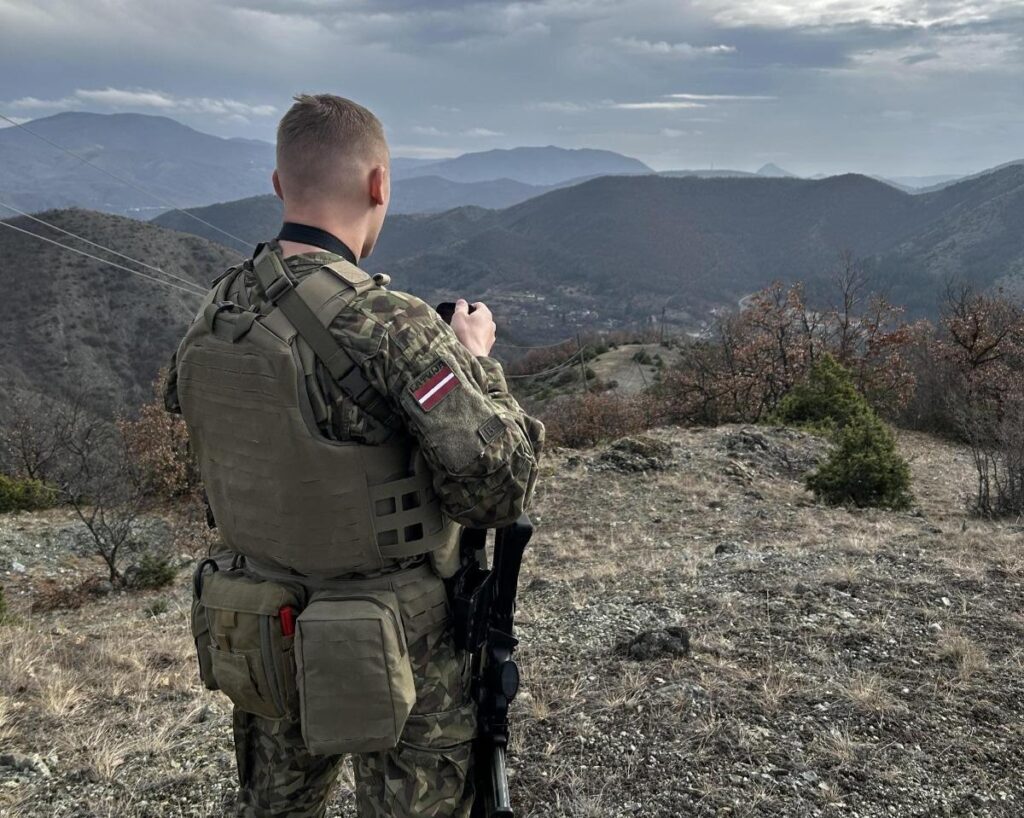
The Western Balkans
The countries of the Western Balkans might no longer find themselves the first news item or on the front pages as often as other regions (unlike the former State from which almost all of them emerged – the Socialist Federal Republic of Yugoslavia; SFRJ), but the region remains synonymous with political unrest and discord, ethnic tension, and the enduring impact of the violent dissolution of Yugoslavia. Despite lasting peace agreements including the Dayton Peace Accord and the UN Security Council Resolution ending the short and bloody Kosovo conflict in 1999, numerous unresolved questions continue to mould the political environment in ways that still threaten to make the region a dangerous flashpoint on the European continent.
One reason why the region remains a source of instability is the absence of a common approach to democratic good governance. The region also continues to be divided along ethnic, religious, and political lines, shaped by the policies of powerful external players, including, but not only Russia and the EU, but China and Turkey wait eagerly in the wings for more influence should Brussels weaken its interest. Contrary to some views, Russian influence remains strong, most notably in Serbia and the so-called ‘Serb half’ of BiH, while the EU’s enlargement project has been viewed as increasingly dysfunctional, with relatively new EU member states, such as Bulgaria, slowing the accession of countries like North Macedonia. As the world watches every move on Ukraine as it fights for survival, many might argue that the international community has begun to ignore the simmering tension in the Balkans, and by so doing, is contributing to an environment where autocratic local leaders are becoming increasingly emboldened to pursue their own ethnic or nationalist agendas.
Bosnia and Herzegovina: Stumbling towards disintegration?
The current situation in Bosnia and Herzegovina (BiH) poses significant challenges to the country’s stability in a year when the 30th anniversary of the 1995 Dayton Peace Agreement is commemorated. While this agreement succeeded in halting hostilities, it created a fragile political framework dividing BiH into two separate entities: the Federation and Republika Srpska (RS). This construct was designed principally to safeguard the interests of BiH’s three ‘constituent peoples’ but has also opened the door to the disintegration of the country. One of the most divisive local leaders, Milorad Dodik, RS President, has taken this opportunity and repeatedly advocated for the RS entity’s secession from BiH, undermining the very bedrock of the country as established by the Dayton Accords. The situation has recently taken on a new twist, with the sentencing of Dodik by the State Court of Bosnia and Herzegovina to prison (for one year) for “undermining the country’s state institutions and violating the BiH constitution” after Dodik’s years-long defiance of decisions of state-level bodies and rulings of the international High Representative, German official Christian Schmidt. The sentence highlights the institutional challenges the country faces in administering the rule of law and governance overall. The sentence has also further aggravated divisions, as Dodik’s followers see the court’s decision as being politically motivated, while his opponents claim it is a step needed to uphold the integrity of the state.
BiH’s central authorities have now stepped up efforts mid-March to arrest Dodik as the ongoing crisis threatens to deepen further. The EU-led military force on the ground OP/ALTHEA has temporarily increased its troop numbers by 400 given the heightened tensions. The Court of Bosnia and Herzegovina has issued a nationwide arrest warrant for Dodik, alongside two associates. Meanwhile, Dodik’s announcement of plans to establish a separate RS border police force has poured further fuel on the fire; cynically, he has insisted these recent moves would be in line with the Dayton Accords. There are fears of further separatist moves and Dodik has appealed to Russian President Vladimir Putin and Hungarian Prime Minister Viktor Orbán for support. In response to Dodik’s actions, EU and US officials have condemned his efforts to undermine the Dayton Peace Agreement, warning that his increasing ties with Russia and defiance of BiH’s sovereignty threaten regional stability and peace.
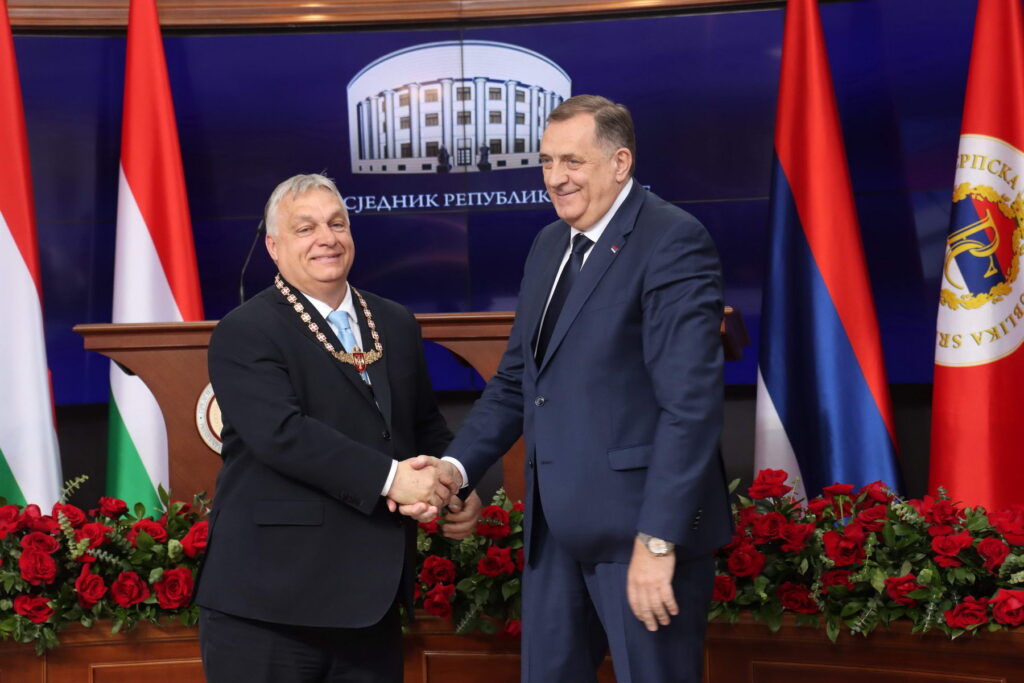
Reacting to the verdict, President Aleksandar Vučić of Serbia leapt to Dodik’s defence (even travelling to RS to deliver his message in person), where he sharply criticised the judgement, labelling it a direct attack on the rights of all Serbs in BiH. A long-time Dodik supporter, Vučić claimed that the international community, particularly the EU and the US, targets RS, while ignoring BiH’s complex political reality. Vučić’s defence of Dodik not only underscores Serbia’s role as an ally of RS and defender of Serbs throughout the region, but also highlighted the region’s fragile environment. Vučić’s kin-state commitment to Serbs in BiH is reminiscent of the outbreak of conflict in the early 1990s and the creation the Serb breakaway ‘republic’ in Croatia (Republika Srpska Krajina) and the initial founding of the RS in BiH. This has only made efforts to stabilise the country even more complicated, so long after the end of the conflict.
On 31 March 2025, Dodik travelled to Moscow via Serbia, and was received by President Vladimir Putin, in spite of a BiH arrest warrant issued against him, before returning to BiH.
Serbia: Protests, more protests and political polarisation
However, all is not well at home for Vučić either. While he continues to defend the rights of Bosnian Serbs next door in BiH, within Serbia itself the largest protests for many years have taken place on a regular basis across the country, since a tragic collapse of a train station’s roof in Novi Sad on 1 November 2024, causing 15 deaths. The deadly incident exposed a deep level of discontent within Serbian society, notably among university students. From the outset, the protests consistently called for accountability for the Novi Sad tragedy and for wider rule of law reforms. Demonstrators believe that Vučić has become emboldened by a Trump victory, combined with a Europe preoccupied with Ukraine, making him increasingly authoritarian; they also note the government’s control and manipulation of the media, and the narrowing space for civil society to engage in a meaningful way. The demonstrations therefore signify a larger political crisis, showcasing increasing polarisation between opposing camps.
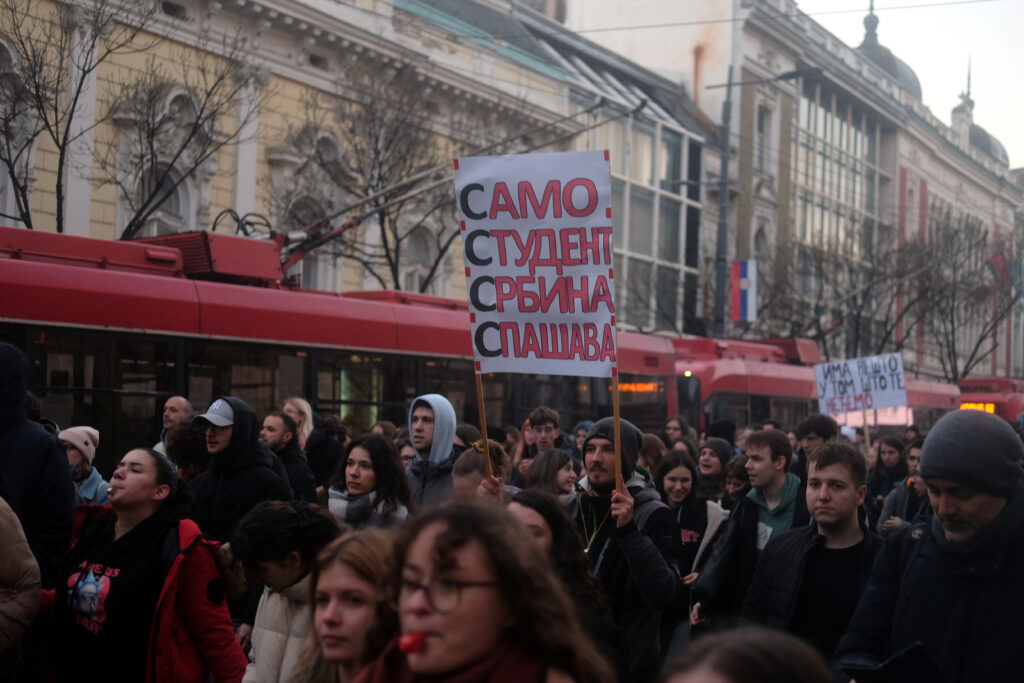
Following the 15 March protest, allegations were made by participants that law enforcement used Long Range Acoustic Devices (LRADs), a type of sonic weapon, to disperse the crowds. LRADs emit sound waves that can cause discomfort or disorientation. Serbian authorities initially denied the use of such a weapon, or even possessing such devices, though videos posted online suggested otherwise. Later, on 19 March, the Ministry of the Interior issued a statement admitting that the Government had indeed procured LRADs, but that these were used for “only used for warning, i.e. sending sound messages during large gatherings”, and “informing a larger number of people at greater distances”. The release also included footage of Interior Minister Ivica Dačić being shown both an LRAD-450XL mounted on a police vehicle and a portable LRAD-100X device during a demonstration. Given the inconsistencies in forming their narrative, the Interior Ministry’s explanations did not come across as particularly convincing, and despite government denials, the allegations persist. If true, as video footage and reports from the ground strongly suggest, they demonstrate the lengths the government were prepared to go to disrupt the protest and cause violence.

In addition to the ongoing protests, Serbia continues to walk the tightrope between keeping Brussels on board – aligning policies with those of the EU, while nurturing ties with Russia and China. Serbia’s main goal may well be EU membership, but its historical relationship with Russia and more recent relationship with China make life more complicated for Belgrade.
An impatient North Macedonia
In North Macedonia, the re-emergence of nationalist rhetoric has become a central feature in the country’s political scene. The ruling VMRO-DPMNE party, since its creation, a long-time and consistent supporter of Macedonian identity and nationalism, has remerged as a considerable force since June 2024 under Prime Minister Hristijan Mickoski. Most notably, the VMRO-DPMNE-led government has become increasingly sharp in its public criticism of the EU and especially its accession and integration policy – recently referring to what they see as “double standards” towards EU candidate countries in the region, and most notably regarding neighbouring Bulgaria’s veto, which has cited issues related to history and language. This frustration has only encouraged growing anti-EU sentiment in North Macedonia, a NATO member, seeing perhaps they have nothing to lose since EU integration is often viewed as a pipe dream anyway (Skopje became an EU candidate in 2005). Interestingly, but perhaps not surprisingly, PM Mickoski travelled to Budapest to meet the black sheep of the EU family, Victor Orbán, where he heaped praise on his Hungarian host as an inspirational leader. Both Prime Ministers welcomed the shift in transatlantic relations and were critical of the EU’s approach on Ukraine.
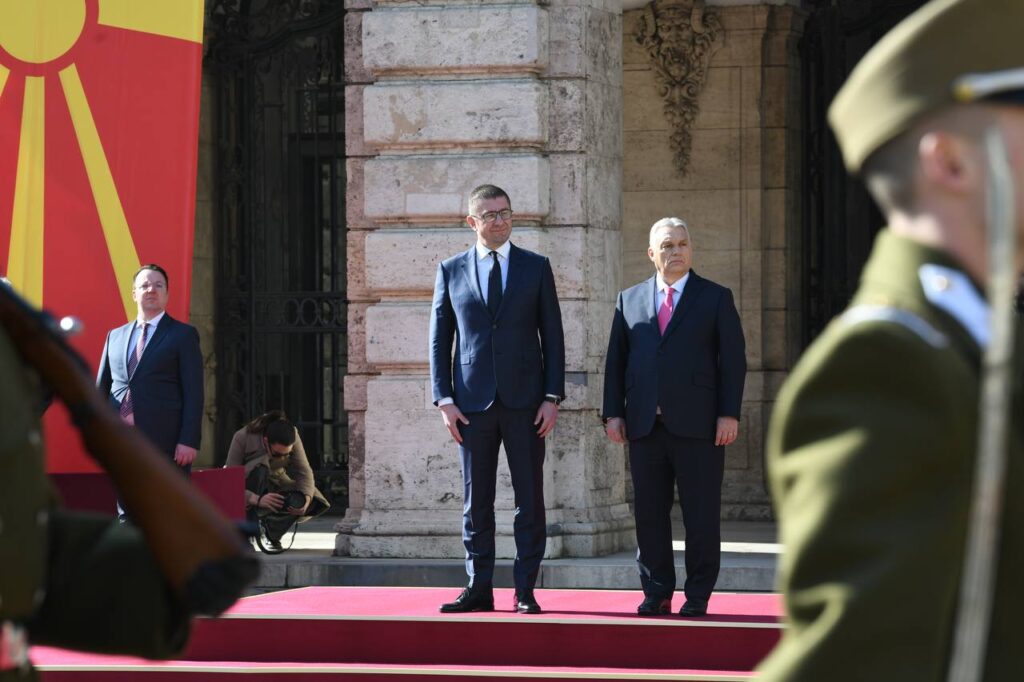
U-turn in relations between the US and the Old Continent: Impact on the Balkans
The new US foreign policy has significant implications for the Western Balkans. Under Trump, the US is rapidly distancing itself from its traditional alliances in favour of more transactional bilateral agreements. This dramatic U-turn will only serve to water down the West’s capacity to influence the political paths of countries in the Western Balkans. Moreover, Trump’s increasingly Russia-friendly view, combined with an almost total indifference to the EU’s enlargement project (for instance with respect to the Western Balkans), has created a situation where local leaders might become even more emboldened to pursue their own agendas, knowing full well no meaningful action or sanction will follow.
While it is true the US continues to be engaged in the region, including with a small military presence in Kosovo, comprising roughly 600 troops serving with the NATO-led Kosovo Force (KFOR), the current situation with Ukraine means that countries such as BiH, North Macedonia and Serbia will no longer enjoy the same levels of attention as before. Many predict that the EU will struggle to maintain a unified approach to the region, since the EU’s enlargement process has largely stalled, and with some EU Member States, including Bulgaria, blocking accession paths based on bilateral disagreements; this is nothing new, as previously seen with Slovenia stalling Croatia’s EU accession. As a result, unless the EU reassures the candidate countries that their offer of membership is real, there are those who will continue to be frustrated and disillusioned, adding fuel to nationalist tendencies and momentum behind choosing an alternative path.
Conclusion
The Western Balkans region is at a critical juncture. Internal discord, continuing ethnic tension, political instability, societal frustration with a lack of reforms and widescale corruption, in addition to pockets of rising nationalism, all represent challenges to the region and its stability. The impact of the Ukraine conflict will continue to be keenly felt in the region and with a resurgent US foreign policy regarding that conflict, uncertainty in the Western Balkans will only deepen. Without a stronger hand from Brussels and concrete membership perspectives, many feel the region is increasingly being left alone, and at risk of being forgotten. BiH’s brittle state construct and secessionist moves underway, coupled with protests in Serbia (which show no sign of abating), and the sharper, more strident language from Skopje, are all symptomatic of a wider problem – the inability of the Western Balkans’ to fully integrate into the European space. This means they are even more exposed to external influence from Russia, and increasingly so from China. As the world’s attention is again firmly on Trump and his pledge to bring peace in Ukraine (seemingly at any cost), the Western Balkans are in a vulnerable and increasingly fragile position. European security is far from certain in this part of the Old Continent.
Lincoln Gardner






